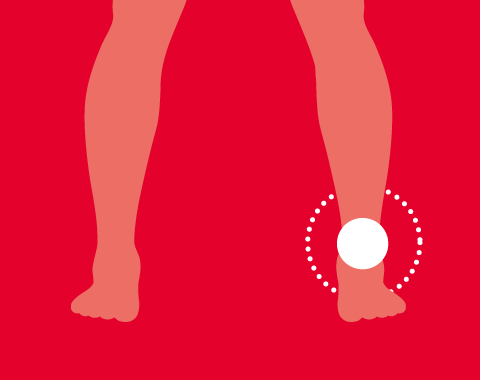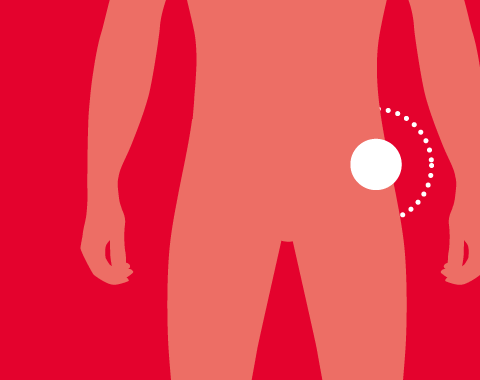Whether preparing for your latest marathon or simply going for a brisk jog after work, running injuries can occur at any intensity or skill level. We’ve compiled a list of a few of the most common injuries affecting runners, symptoms to look out for, as well as prevention and recovery tips.
COMMON RUNNING INJURIES
As you would expect, the hips, knees, feet and legs in general get the brunt of injuries when running. These injuries often start with a slight niggle and become increasingly bad over time if left untreated. To enable you to identify and treat damage caused by running quickly, below is a list of potential causes and symptoms to look out for.
Knee Injuries
RUNNER’S KNEE
Runner’s knee (AKA Patellofemoral Pain Syndrome, or PPS) is the most common of all injuries sustained while running, accounting for 16.5% of all reported ailments. Runner’s knee occurs when the kneecap becomes slightly misaligned, causing the cartilage between the kneecap and the bones of the leg to rub against each other, resulting in pain and swelling.
What to look out for: a persistent, faint pain at the back of the knee or at the top of the kneecap. Touching the kneecap may also cause discomfort.
Foot Injuries

PLANTAR FASCIITIS
Likely to be the most common foot injury affecting you during your running career, Plantar Fasciitis is an injury caused by over extension of the plantar fascia tendon, which runs along the bottom of the foot. Repeated over extensions of the plantar fascia leads to the tendon becoming damaged and tender.
What to look out for: a pain under the heel, which can vary from a minor discomfort to extremely painful, depending on the level of damage to the plantar fascia. Pain behind the heel (and not underneath) may be Achilles Tendonitis (see below).
STRESS FRACTURE
A stress fracture occurs when one of the many bones comprising the foot develops a minute crack or fissure. This can be a gradual process, suddenly exacerbated by a shock or impact. Stress fractures can occur when the intensity of a running regimen increases suddenly, without enough time given to for the body to adapt. As a result, those training for a marathon, half marathon or other long distance run are particularly at risk.
What to look out for: swelling of the foot is a giveaway. Pain in the foot while running that subsides when you’re resting and tenderness around the affected area are also signs of a stress fracture.
Leg Injuries

ACHILLES TENDINITIS
Achilles Tendinitis occurs when the Achilles tendon, connecting the calf muscle to the heel bone, becomes inflamed from overuse, or from running without properly warming up. This manifests as swelling and pain in the heel.
What to look out for: pain in the calf can indicate an issue with the Achilles, as can discomfort and swelling at the back of the heel. If you are experiencing pain under the heel, you may be suffering from Plantar Fasciitis (see above).
SHIN SPLINT
Shin splints, (AKA Medial Tibial Stress Syndrome, or MTSS), comes about as a result of a rapid increase in training duration and intensity when the leg has not yet developed the strength to deal with the increased impact force of a tougher or longer lasting run.
What to look out for: A general pain along the length of the shin is the clearest indication of a shin splint, if you can detect one point where the pain is greatest then this is an indication of a stress fracture in the shin bone instead, and should be treated accordingly.
Hip Injuries

IT BAND SYNDROME
The Iliotibial band (IT band) is a thick fibrous band connecting the knee to the hip, and it takes a large amount of strain from a high impact sport such as running. Running downhill especially can cause the IT band to rub against the femur, causing the band to tighten, becoming swollen and painful. Left untreated, this injury can quickly become extremely painful as and will reducing the range of the motion of the leg, making running impossible until treated.
What to look out for: A general pain around the knee joint and on the outer part of the thigh is the clearest sign of IT band syndrome. If the pain is most intense when you bend your leg at a 45-degree angle, then this is a clear sign that the IT band has been damaged.
BURSITIS
If you begin to experience pain in the hip either before or after a run, then this could indicate bursitis, an inflammation of the bursae, fluid-filled sacs, which help to lubricate the motion of the joints during motion. Bursitis is the most common cause of pain in the hip. Bursitis normally appears a result of a tight hamstring or IT band, due to either improper warm up or overuse of the hip joint.
What to look out for: The symptoms of bursitis normally manifest as an aching or burning pain in and around the hip, and a clicking or popping sound during movement of the hip socket.
RECOVERY
Each individual symptom and injury should be assessed by a health professional to determine the correct path to recovery; there are however a few simple steps which you can take which can go a long way to reducing the duration and severity of any injuries you may have sustained.
The most important step that you can take following any injury is to use the
The most important step that you can take following any injury is to use the RICE (Rest, Ice, Compression, Elevation) method. This allows for your body to begin the natural healing process, and will increase the speed of your recovery while also minimising the chances of long-term damage resulting from injuries:
- REST: Stop running, do not put weight on the affected body part, and allow the body’s natural healing process to get to work
- ICE: Icing the affected area improves circulation and speeds up the healing process
- COMPRESSION: Compressing the affected area regulates blood flow, decreasing swelling and increasing the speed at which the injury begins to heal
- ELEVATE: Elevating the leg also helps the body to regulate blood flow to the affected area, helping recovery
Also gently stretch the affected area, to ensure that flexibility is not lost during the healing process.
CoolXChange Compression & Cooling Gel Bandage is the perfect companion following a running injury. The bandage plays an invaluable part in the application of the RICE method, as it both cools and compresses the affected area far more effectively than a standard ice pack, allowing for the best chances possible of a full and quick recovery. It doesn’t need refrigeration and is reusable so is ideal as part of your post-run routine.
INJURY PREVENTION
There are several steps you can take to prevent or minimise the risk of an unpleasant injury while running:
- Build up strength in the legs, knees and hips evenly, to ensure that the body can take the stresses of running long distances.
Be attentive to your body! If you start to notice any discomfort it’s better to recognise and treat it at the earliest possible point, before it has the chance to really put a dent in your running schedule - Make sure you wear comfortable shoes that fit well. Many running injuries come about as the result of poorly fitting running shoes, which lead to a myriad of damaging and unnecessary stresses and strains being put on the body
- Ease into your workout routine, no one can go from being a couch potato to running a marathon overnight, increase the distance and duration of your runs gradually, to allow time for your body to adjust
- Remember to stretch before you begin to run, allowing the muscles to loosen and warm up, and for blood to begin circulating. However, if you run for longer than 15 minutes do not stretch immediately after your run.
- After a long distance run your muscles will be covered with micro tears, which is a normal part of the muscle increasing its strength, however, stretching immediately after a long run could further damage the muscles, leading to injury. In this case, it is better to drink plenty of fluids and warm down later
- Post-run, ensure you replenish lost fluids and nutrients to help your body recover quicker
- Run on level surfaces whenever possible; running on rough, uneven terrain vastly increases the likelihood of injury and wear and tear on the legs, knees and hips
- Foam rolling is uncomfortable, we know, but doing this after your run is also strongly recommended to avoid injuries. Rolling helps release knots in your muscles, which left unattended can lead to many of the injuries outlined above. If you’re new to foam rolling or want to learn more, read A Complete Guide to Foam Rolling, and download the free exercise sheet.
Whether you run for sport, exercise or simply because you love it, there’s no doubt that it is one of the most challenging and rewarding activities out there. Running has many upsides, but you have to take care of your body and respond quickly when you notice a pain or twinge or it can lead to bigger problems in the future. If you have noticed any of the above symptoms, speak to your health professional about it as it’s usually relatively simple to remedy. Happy running!
Must-have items for your running kit:
 CoolXChange supports active lifestyles. The gel bandage provides cooling and compression with no need for refrigeration. Keep the bandage handy in your gym kit or your glovebox. Find out more and buy.
CoolXChange supports active lifestyles. The gel bandage provides cooling and compression with no need for refrigeration. Keep the bandage handy in your gym kit or your glovebox. Find out more and buy.
 Thermoskin supports and braces are designed to assist with prevention and pain management of soft tissue injuries and joint pain. Find out more and buy.
Thermoskin supports and braces are designed to assist with prevention and pain management of soft tissue injuries and joint pain. Find out more and buy.



Recent Comments